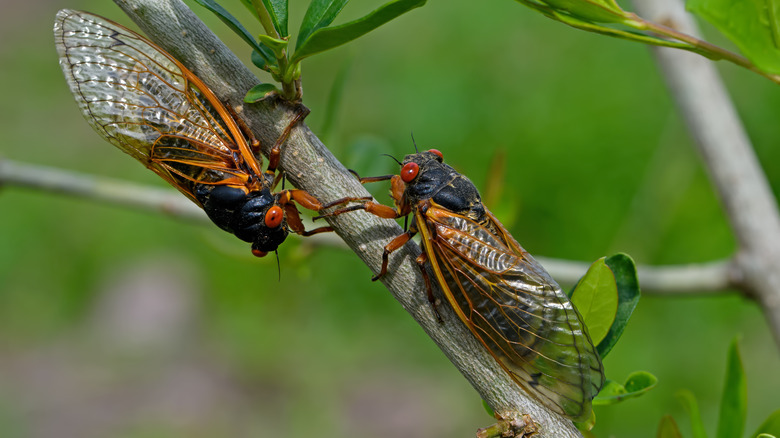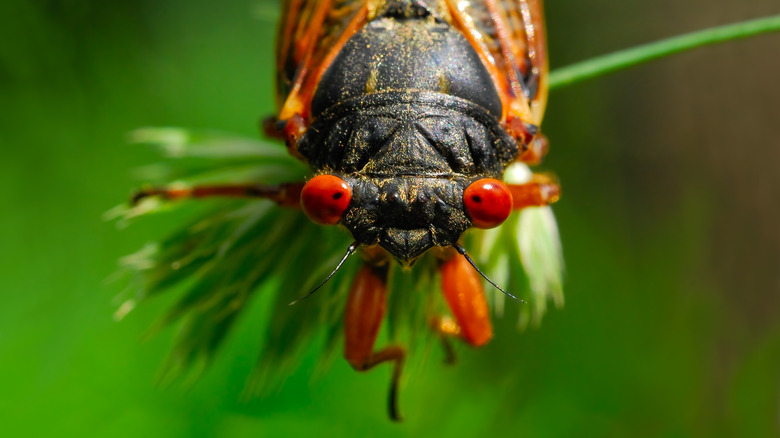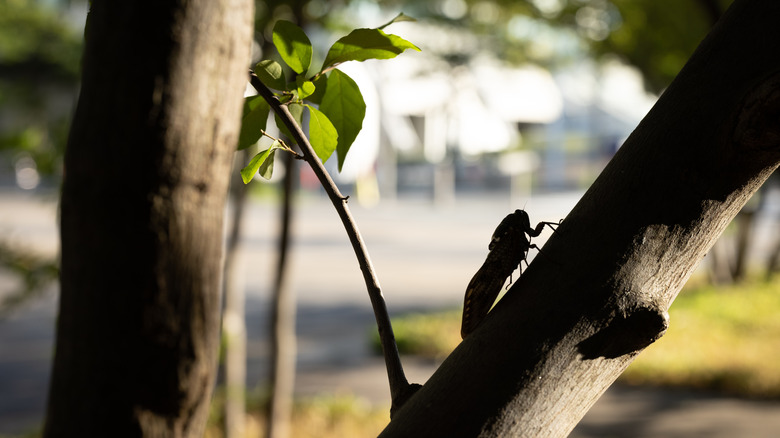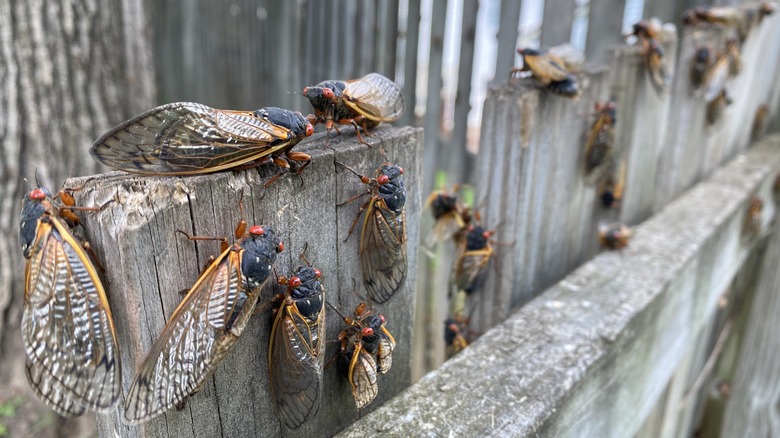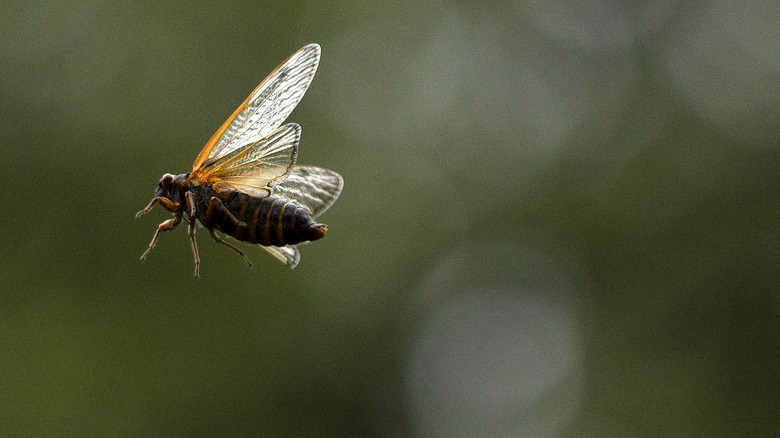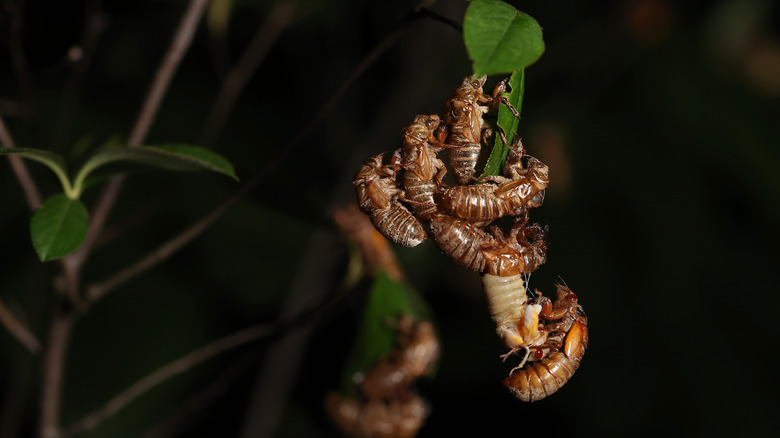An 'Insect Apocalypse' Is Happening In 2024. Here's What You Need To Know
They burrow into the ground and live under our feet without sunlight for years upon years, feeding off of tree sap. When fully grown they emerge in unison for one purpose, and one purpose only: to reproduce. They live for three to four weeks in the open air, mating, laying eggs, and then dying. Each female produces up to 600 eggs mating with males and lays them in tree branches. When the eggs hatch the nymphs — wingless babies — fall to the ground, burrow into the soil, and repeat the cycle. Different broods — species — follow different cycles, usually 13 or 17 years. And if you don't see the swarm of trillions with your own eyes, you'll definitely hear them, even if only for a little while — especially in the United States in 2024.
That's right, 2024 represents a rare opportunity for nature lovers, insect fans, and two overlapping broods of cicadas: Brood XIII and Brood XIX. But fear not, because cicadas aren't dangerous at all — they're just noisy and leave their exoskeletons behind on your porch. Plus, they aerate the soil and do all sorts of helpful stuff for the environment, including making good snacks for predators. The current brood-pocalypse is a once-every-221-years convergence, with the next one set way after any of us will be alive in the year 2245.
A strange and curious insect
Cicadas are curious insects, it's true. They have the longest life cycle out of any insect in the world — 17 years for certain broods. They've existed for about 5 million years, and there are over 3,000 different cicada species worldwide, particularly in South and Central America and across Asia. They're about 1 to 2 inches long, kind of chubby, have wideset red eyes, can't fly too well, and have so little awareness of predators that they don't try to escape threats. But that's okay, because there are just too many of them to wipe out.
When cicadas burrow up from the soil they're still not adults. They've got to emerge, molt, and get their wings before they can start their reproductive cries. Male cicada bodies are largely big air sacs that they use to "sing" to mates. Oftentimes, male songs catch the attention of other males, who join together in a colossal chorus to attract females. Those who've heard cicadas up close, however, know how loud even one can be.
Cicadas tend to hang out in forested areas — National Geographic says in some regions there are up to 1.5 million of them underground per acre. There are so many of them that the Ecology Society of America once estimated that their total biomass for a given area is greater than the biomass of cattle the same area would be able to sustain. And in 2024, National Geographic says we're looking at trillions of cicadas across certain areas of the U.S.
A rare, 221-year convergence event
Cicadas are homopterans, insects adapted to sucking up plant sap. There are over 32,000 such species worldwide, some usually harmless like leafhoppers, and others like aphids very destructive to plants. 2024's cicadas are periodical cicadas. Underground, they burrow tunnels and suck up tree sap. As for the peculiarity of their 13- or 17-year cycle, no one really knows for sure why cicadas have adapted this way or how they know when it's time to emerge. It's easy to think that resource scarcity might have driven them underground to begin with and toward a liquid diet. As for their emergence time, cicadas might detect the composition of tree sap and use it to gauge seasonal cycles.
Because some broods operate on a 13-year cycle and others a 17-year cycle and each has a different starting date, it's a rare event when multiple broods emerge. The last time that Brood XIII and Brood XIX popped up with in 1803. In 2024, Brood XIII will show up in late April to mid-May in Illinois, Iowa, Indiana, and Wisconsin. Meanwhile, Brood XIX will show up in mid-May and cover a much larger area of Arkansas, Georgia, Kentucky, Illinois, Indiana, Alabama, Missouri, Oklahoma, North and South Carolina, Virginia, Mississippi, Louisiana, and Tennessee.
Harmless, if annoying
Aside from doodabs of cicada knowledge, some people may be very practically wondering: "What do I do about these bugs, anyway?" The answer is, "Nothing." As mentioned, cicadas are harmless. They don't bite or sting (and actually can't), aren't aggressive at all, don't swarm like locusts, are bad fliers that can only travel a few hundred feet before calling it quits, and exclusively feed on tree sap. Basically, they're the most benign insect you could imagine — and they even stay out of sight for 13 or 17 years at a time.
That being said, some folks will find cicadas creepy, no matter what. If there's enough of them in one area they might leave behind a carpet of crunchy exoskeletons on the ground, which yes, is a bit off-putting. Or, their empty husks might stay stuck to trees. Or, a squirrel might grab a husk and race off to have a little snack — who knows? And when cicadas are dying after their brief three-or-four-week stint out of the soil, they tend to fall to the ground, land belly-up, and stay completely still aside from the occasional twitch, which can be a little disturbing or startling.
And yes, lots of people don't like the sounds they make. But cicadas aren't even harmful to gardens, including young plants, because they don't eat plant matter. At most, they might drop to your porch or sidewalk when their lives are nearly over.
Not quite a Biblical reckoning
For some, hearing that "trillions of cicadas will descend upon the land" may conjure images of locusts from the biblical plagues described in the Bible's Exodus 10: "They covered all the ground until it was black. They devoured all that was left after the hail — everything growing in the fields and the fruit on the trees. Nothing green remained on tree or plant in all the land of Egypt."
According to National Geographic, this is exactly what the Puritans in Massachusetts thought in 1634 after they'd arrived in the New World — that cicadas were the locusts of biblical lore. Yes, some cicadas are black, but they don't devour anything while they're above ground. In fact, they barely eat at all during the adult stage of their life cycle (above ground) aside from the occasional plant sap. So the "insect apocalypse" you've heard mentioned? Not quite. You're not going to get covered in the things unless you sleep outside in the forest in the middle of one of their emergence zones.
If anything, in 2024 humans will get to witness not the cicada apocalypse but a massive cicada party. After emerging, molting, singing, mating, and laying eggs during their three-week bash in the trees, the adults die and their eggs take about six to 10 weeks to hatch. The nymphs then drop to the ground and vanish until the next party. Cicadas really only exist to perpetuate the brood.
Those with sensitive hearing: beware
No matter how harmless cicadas are, there's one thing to be careful of in 2024, aside from an empty husk falling on your head when you walk under a tree. Johns Hopkins Medicine talks about how cicada noise can be difficult on those with sensitive hearing, particularly those with tinnitus — a fairly common disorder that involves hearing ringing inside the ears. Cicada sounds can bother such people because the sounds can reach 100 decibels, the volume of a factory full of machines.
On this note, nurse Rachel Hisim has some practical advice for folks with hearing sensitivities: "Though we can't always remove the sound irritant from our environment, we can remove ourselves from certain environments to decrease noise exposure and the possibility of worsening ear ringing." In other words: Don't go near the cicadas.
A world-changing insect
A 2023 Science study found that back in 2021, the appearance of Brood X alone altered the food webs of affected areas, particularly bird behavior, flight patterns, and hunting. "This study shows that massive resource subsidies can have far-reaching ripple effects through forest food webs" said study co-author Daniel Gruner, a professor of entomology at the University of Maryland. "Because the Brood X periodical cicadas emerged in the billions across 15 states, their indirect ramifications were geographically extensive."
A twin-brood event is likely to yield an even greater environmental impact, but in a good way. Cicadas not only provide food for predators above ground but also serve a vital function in the soil by aerating it and helping roots get oxygen. So please: If you've just got to squash a cicada, at least let it finish its party first.
As soon as this year's dual-emergence convergence event concludes, Broods XIII and XIX will be gone for another 17 years and 13 years, respectively, until they can once again make their mark.
